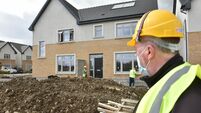Taoiseach defends housing target removal as developer says 'we could be doing so much more'

The 'Delivering Homes, Building Communities' plan promises the delivery of 300,000 new houses by the end of 2030, meaning an average of 50,000 houses need to be built each year. File photo
The Taoiseach has defended the removal of annual targets for overall housing delivery, as the Government launched its new housing plan.
It promises the delivery of 300,000 new houses by the end of 2030, meaning an average of 50,000 houses need to be built each year.
The plan also promises to build 12,000 new build social homes each year.
However, there are no longer yearly delivery targets, unlike the previous Housing for All plan.
The plan proposes the establishment of a new ‘starter homes’ programme, which would deliver 15,000 affordable housing supports each year. These supports stem from existing schemes, including Help To Buy and the First Home scheme.
Within the plan, there is a promise to deliver “more cost-rental homes” for renters, but it does not outline a target. Extra funding will be provided to local authorities who exceed their new-build social housing targets, the plan says.
The plan also targets the return of 20,000 vacant homes into use, through the existing Vacant Property Refurbishment Grant.
On homelessness, the plan confirms there will be €100m provided for buying up second-hand homes to help get families out of emergency accommodation who have been there for the longest periods.
The development of a new cross-Governmental Child and Family Homelessness Action Plan has been promised, as well as a new homelessness prevention framework.
As previously reported by the , there will be a further €2.5bn allocated to the Land Development Agency, which is expected to support its expanded remit to deliver private housing.
For the construction sector, the plan contains a commitment for a new ISIF-led €400m equity risk capital investment programme for housebuilding over the next three years. This is set to provide more equity to small and medium-size builders.
There are also commitments to further expand the use of modern methods of construction, with a target of its use in 25% of all social and affordable homes built during the plan's lifetime.
The plan also contains a commitment for a new “revamped local authority voids programme”, which aims to incentivise a quicker turnaround time for vacant social homes.
Many of the measures within the plan had been previously announced, including changes to the rent sector, reforms to apartment guidelines and Vat rate cuts on the sale of apartments.
Reacting to the plan, developer Michael O’Flynn said the country "could be doing so much more" when asked about the rate at which houses are being built in Ireland.
Speaking on RTÉ radio’s , Mr O’Flynn warned that there was no point in talking about the numbers being mentioned in the plan “if we don't change how we are doing things".
“And I mean change," he said. "Because when I look at our pipeline, we could be doing so much more than we are."
He said the Land Development Agency "is doing a very important job at this moment in time and we're certainly one of many developers working with them, but all of a sudden they've been told they're going to get involved in the whole market".
“These are big statements, but I do not see how that can happen quickly. I cannot see how we can get to the numbers we have, unless there is a serious reset.
“We need a reset of minds. And we need a reset of action. That has to happen. This report in itself won't do anything. I want to see how is it going to be done, who's doing what, what are the changes in zoning, infrastructure.”
Speaking at the plan’s launch, Taoiseach Micheál Martin said the Government was determined to “do whatever it takes” to solve the housing crisis.
“Housing is at the core of this government's agenda, and it is the defining issue for our people with profound social and economic impacts,” he said.
Tánaiste Simon Harris said the Government was "throwing lots of money" at the housing crisis, saying the challenge was now to speed up the delivery of houses.
“We’re trying to provide the market, [and] the country with greater policy certainty in terms of housing for the years ahead.”
Mr Martin also defended the removal of overall annual housing targets.
“When we had the annual targets under Housing for All and when we exceeded those targets, the annual ones, the riposte was ‘well, you should have set the targets higher and they weren’t high enough,” Mr Martin said.
“The bottom line is, we need 300,000 homes.”
He denied there was a removal of metrics to judge the Government’s progress, while Mr Harris said there would be completion figures and commencement notices published regularly.
Mr Harris added that the Government was being specific on the number of houses the State was delivering, such as social houses.
“The others are being delivered by the private sector and the role of the Government is to be the enabler,” Mr Harris said.
On homelessness, housing minister James Browne said the cross-Governmental action on child and family homelessness would be published in the first half of 2026.
It is understood that the development of the action plan will be driven by homeless organisations, rather than the Department of Housing.
Pressed on when the public would begin to see child homelessness fall, given the provision of €100m next year to exit families from homelessness, Mr Browne declined to set out a timeline or figure.
In September, there was a record 5,238 children recorded as living in emergency accommodation.
Mr Browne said that one child in homelessness was “one too many” and he was determined to put an end to child homelessness.
“We can’t address the homeless as a homogenous group. People are becoming homeless for very different reasons,” Mr Browne said.
Mr Browne said different forms of homelessness needed to be addressed in different ways, saying wraparound services were needed for people who have mental health or addiction issues.
This would be different to the services required for a family in homelessness, he said.
Pressed further, Mr Browne said it is his priority to “maximise the number of families out of homelessness”.
However, he said he did not want to provide a specific number of children who would exit over the next year because that becomes the “pure driver in and of itself”.











